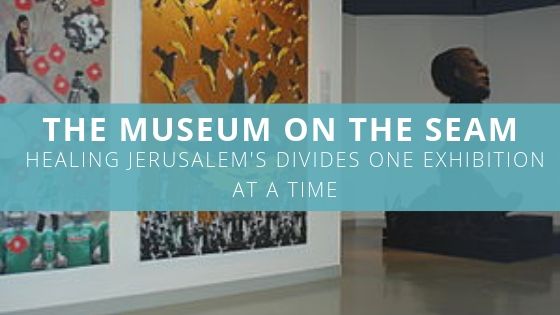There is no shortage of creative and innovative projects working to build bridges between Israelis and Palestinians. For example, the Jerusalem YMCA Youth Choir brings people together through music; the Peres Center for Peace does so through sport; and the Museum on the Seam — which CCFP recently visited — uses socio-political contemporary art.
The Museum on the Seam is built — as its name attests — in an area referred to as “the seam,” which is an invisible line running through Jerusalem where the eastern side of the city, primarily populated by Palestinian Muslims, meets the western side, which is primarily populated by Israeli Jews.
After decades of national conflict, these places where Israelis and Palestinians intermingle can be places of tension and discord, and sometimes even violence. Some, however — including Raphie Etgar, the founder and chief curator of the Museum on the Seam — have seen their potential as places for nurturing togetherness and understanding.
The building the museum is housed in was formerly a military outpost stationed on the ceasefire line between Israel and Jordan, when the two countries controlled different parts of the city. Now, it houses socio-political contemporary art museum committed, in its own words, to “advancing dialogue in the face of discord and to encouraging social responsibility that is based on what we all have in common, rather than what keeps us apart.”
“This country bears so many conflicts and disagreements, every day, again and again,” Mr. Etgar told us. “Many good people in this country are trying their best to make a change and bring peace and common sense, or at least reduce the conflicts. This museum specifically, I thought to myself, would do the same thing but in a different way, and that is through art.”
For many years now, that is exactly what the museum has done; bridge gaps by facilitating dialogue and discussion through art exhibitions focusing on the social and political issues of the day. They don’t focus only on the Israeli-Palestinian conflict, but also on the various other conflicts present within Israeli society.
A recent exhibition, called “Thou Shalt Not,” examined the intersection between religion, which is often rooted in tradition and a disinclination toward change, and contemporary art, which serves as a mirror reflecting the rapidly changing times. The exhibit featured works by 30 artists, half of whom are religious and half of whom are secular.
“We don’t think that our exhibitions are right or wrong, because this is not the point. The point is to put things on stage and let people discuss it. The discussion is the most important thing, because the discussion — if people do it the right way — brings them closer,” Mr. Etgar said. “The museum is here to let people meet, and maybe this is the way they will agree. If not on everything, then on something. And that is quite enough.”
In the past, their exhibitions have facilitated discussion on the problem of violence within Israeli society, the interaction between humans and nature, issues of discrimination, exploitation, and humiliation, and much more.
One of their most popular exhibitions, called “Coexistence,” was designed to bring a positive message of diversity and acceptance to the world community. It features works created by artists from all over the world and is still traveling to various locations, now having visited more than 30 cities.
As Mr. Etgar sees it, one of the most important things these exhibitions have demonstrated is that people, even those who would consider themselves enemies, are more closely connected than they might think.
“There’s always part of ‘the other’ in ourselves,” he said. “If you take the time to think about it, you’ll realize that even your enemy has some part in you. It might be the part that upsets you, makes you angry, makes you concerned, but this is the part that’s in you. It’s part of you and there’s nothing you can do about it. I believe that we don’t think completely isolated from all these parts that are included in us.”
At CCFP, we applaud the work that is being done to build bridges through art at the Museum on the Seam, and look forward to a more peaceful future.

